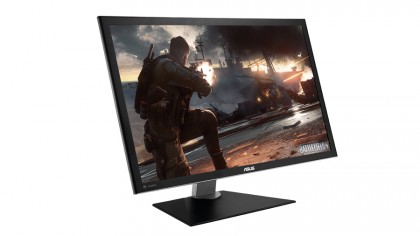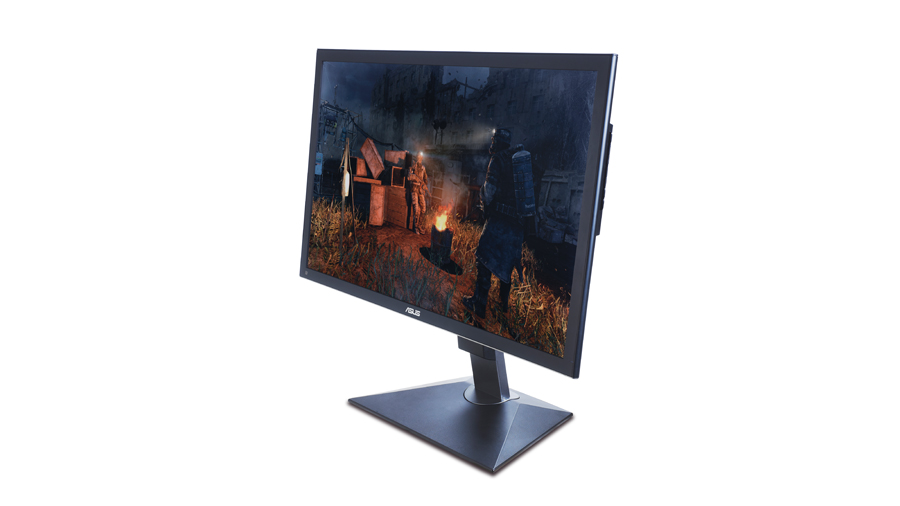TechRadar Verdict
Pros
- +
Excellent image quality
- +
4K resolution is astounding
- +
Good viewing angles and black levels
- +
No hint of IPS glow
Cons
- -
Too expensive
- -
Some driver/connection issues
Why you can trust TechRadar
Thirty inches. 2,560 by 1,600 grid. Four million pixels. That was the gold standard in PC displays. But it's just been blown away. Welcome to the wonderful world of ultra-high-definition visuals.
With this outrageous (and expensive) flatscreen, Asus is giving us our first taste of 4K resolutions. It might just be the next big thing in PC graphics. Can it possibly live up to the hype?
Let's not get ahead of ourselves, here. On the CPU side, for instance, Intel's been sandbagging on an epic scale. Recently, we've had the new Core i7-4960X - a flagship CPU that made barely any difference to performance at all.
Then there's the graphics. AMD and Nvidia have at least been keeping each other honest on the performance side. That includes a brand new flagship GPU from AMD, which should start shuffling out on to shelves very soon. However, the two manufacturers are also keeping graphics prices painfully high.
So, that's the context for the arrival of this new hyper-spec screen from Asus.
It's the largest true PC monitor we've seen, at 31.5 inches diagonally, and it's also the most expensive. It's therefore tricky to immediately take the Asus PQ321QE seriously. If we're fed up with the price of graphics cards, what are we supposed to make of a screen that cost 10 times as much?
Here's the thing. This panel is so exceptional, so spectacular, that it demands your attention at any price. The big news, of course, is the 3,840 x 2,160 pixel grid. Strictly speaking, it's not quite 4K (or 4,000 horizontal pixels), but 160 pixels shy makes little difference to the viewing experience.
It's made possible by indium gallium zinc oxide (IGZO) technology, which takes the place of amorphous silicon in standard TFT LCD panels and allows for smaller pixels, while maintaining light transmission. In other words, you can have really high resolutions without losing brightness.
Four in hand
Anyway, it's precisely four times the resolution of a 1080p full-HD panel. In some quarters, this four-times metric has caused some consternation as to whether it was a marketing ploy. After all, it's only double the horizontal and vertical pixels.
If you're in doubt, the best way to think about it goes like this. Take a 1,920 by 1,080 Full HD pixel grid and super impose it top left on the Asus's 3,840 by 2,160 grid.
It'll stretch halfway across and halfway down. Then stick another 1,920 by 1,080 on the right. You've covered half the screen. Add two more below, and bang - four 1080p grids and four times the resolution.
Advanced mathematics aside, what follows is all manner of goodness.
First is general sharpness and image quality. You may be used to seeing high DPI and tight pixel pitches on your mobile devices, but experiencing it on a screen of this scale is truly spectacular.
Admittedly, mobile devices still trump the Asus PQ321QE for sheer pixel density. The Asus sports pixels measuring 0.182mm across, whereas an iPhone 5's pixels are less than half as big - just 0.07815mm across - but the initial impression is still of staggering clarity and sharpness, the likes of which you've never seen before in a desktop display.
Next up is screen real estate - loads of it. We're accustomed to using 2,560 x 1,440 27-inchers and 2,560 x 1,600 30-inchers. But this thing blows them away. Somebody has finally come up with a panel that makes those existing high-res panels feel cramped.
The inherent quality of the panel is outrageously good, too. If you've been wondering why not many monitor-makers bother with PVA tech these days, this panel comes along and gives that oft-overlooked panel type a much-needed shot in the arm.
It matches or bests the top panels out there for contrast, viewing angles, saturation and black levels, for starters. Then it blows them away with far superior colour accuracy and zippy response, free from overdrive-related nasties such as inverse ghosting.
It's also worth noting that there's not a whiff of IPS glow and the anti-glare coating is smooth and sparkle-free.
Higher than high
Our next port of call is video quality.
What's really interesting here is that high definition video is typically pegged at 1,920 x 1,080 pixels. That's currently Full HD, and it's what all our brains are tuned to, so when you fire up some 4K content (there are demo streams on YouTube, among other sources), the results are spectacular.
It genuinely feels like looking through a window into an alternative reality - one that's as sharp as the real world, but brighter and more vibrant. Move over stereoscopic 3D: this is where it's at.
When it comes to games, however, the step up isn't quite so dramatic. The reason for that, of course, is that we're accustomed to seeing games rendered at true 2,560 x 1,440, or 1,600 on similar-sized panels. At 3,840 x 2,160, the Asus PQ321QE does look better - it's nothing less than superb - but if you're used to existing beyond-1080p panels, it's not quite a life-altering improvement.
Heavy load

The bottom line is that the Asus PQ321QE looks utterly sublime, but there are issues, and we're not just talking about the price. The first is the monumental load that 3,840 x 2,160 pixels puts on a graphics chip. Do the sums and we are talking about in excess of eight million pixels on this panel.
Ideally, you'd want those pixels updated at a rate of at least 30 times a second - preferably faster. Net result? Your GPU has to process and then pump out roughly 250 million pixels per second. It's a number that's almost beyond comprehension, and it says a lot about modern graphics tech that it is actually doable.
In all but one of the game benchmarks, a pair of Nvidia Titans will deliver an average frame rate of 30fps (okay, 29fps) or higher. A pair of AMD Radeon HD 7970 GHz cards can make the same claim, even if it's Sleeping Dogs rather than Company of Heroes 2 where the Radeons fall down.
A significant investment in GPU hardware, then, for what would normally be considered marginal frame rates.
What you really want to know is can you get playable frame rates at super high settings? The answer is, it's borderline. I'm really comfortable with the performance of even two Titans at this resolution. At least you know things will get better as new GPUs appear.
Benchmarks
DirectX 11 tessellation performance
BioShock Infinite: 3,840 X 2,160, Max detail, Frames per second
2x Nvidia Titans: 56
2x AMD 7970 GHz: 39
Nvidia Titan: 33
AMD 7970 GHz: 22
Sleeping Dogs: 3,840 X 2,160, Max detail, Frames per second
2x Nvidia Titans: 29
2x AMD 7970 GHz: 25
Nvidia Titan: 15
AMD 7970 GHz: 11
Metro: Last Light: 3,840 X 2,160, Max detail, Frames per second
2x Nvidia Titans: 42
2x AMD 7970 GHz: 32
Nvidia Titan: 24
AMD 7970 GHz: 20
Company of Heroes 2: 3,840 X 2,160, Max detail, Frames per second
2x Nvidia Titans: 20
2x AMD 7970 GHz: 39
Nvidia Titan: 20
AMD 7970 GHz: 17
Grid 2: 3,840 X 2,160, Max detail, Frames per second
2x Nvidia Titans: 66
2x AMD 7970 GHz: 74
Nvidia Titan: 45
AMD 7970 GHz: 42
Love hertz
The final problem is more of a generic question of 2D support for such a huge resolution. It's beyond what DVI can handle, even in dual-link format, so that's out. A single HDMI connection, using the latest spec, can handle the 3,840 by 2,160 resolution, but only at 30Hz refresh.
Take it from us, 30Hz is not good enough; you need to run this panel at 60Hz. In theory, you can drive it at 60Hz using dual-HDMI connections, but real-world support for that configuration seems patchy.
Thus, your main option is DisplayPort. You'll still need to run the display in what's known as multi-stream mode (MST), rather than single-stream mode (SST). The technicalities are a bit complicated, but MST boils down to a halfway house between a true single pixel grid and running the screen as a pair of virtual displays. The key thing with MST is that it shows up as one display to the operating system and applications - most critically, games.
The problem is that it's not fully compatible with rendering prior to graphics driver loading. That means things such as BIOS screens, Windows Safe Mode and all that jazz.
Your mileage will vary depending on the video card. With some, the screen is blank during boot. With others, you'll get the BIOS squished into one half of the display, which is at least usable.
The bottom line is, you'll have to switch modes in the PQ321QE's OSD to guarantee you're seeing things right outside of a fully drivered-up Windows OS, which you won't enjoy doing because the OSD controls are placed carefully to make them almost impossible to use comfortably.
Verdict
This screen is the standard by which others will be judged. OK, hardly anyone will buy it and the price is hard to justify, but for the time being, this monitor is as good as it gets. Well, until someone cooks up a lovely 4K 120Hz panel that is…
Technology and cars. Increasingly the twain shall meet. Which is handy, because Jeremy (Twitter) is addicted to both. Long-time tech journalist, former editor of iCar magazine and incumbent car guru for T3 magazine, Jeremy reckons in-car technology is about to go thermonuclear. No, not exploding cars. That would be silly. And dangerous. But rather an explosive period of unprecedented innovation. Enjoy the ride.
